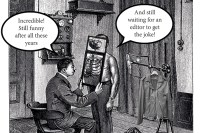Like Covid data, polling data has a built-in time lag of several days. Those sifting the evidence on coronavirus typically expect to see about a four-day lag between someone becoming infected and them showing up as a positive case after getting tested. Indeed, the Financial Times has just produced a graph showing distinct Covid case spikes among young men four days after every England football match in the recent European championships.
Opinion pollsters would recognise a similar lag when it comes to events that influence the standing of parties. It takes time for those events to percolate through the public consciousness.
So the latest rash of opinion polls, which are often referred to as a ‘snapshot’ of the public mood, actually reflect the public mood at the tail end of last week rather than right now. This amounts to ominous news for Keir Starmer, who may today be confusing himself with someone successful.
The narrowing of the Conservative lead over Labour from 10 to 12 points to two to three points can be traced to a woeful week for the Tories. That week involved the party enraging its natural supporters via the pingdemic, Boris Johnson attempting to exempt himself and Rishi Sunak from the same, stories about Covid passports and the daily spectacle of hundreds of irregular migrants landing on the coast of southern England.
But the opposition party’s failure to secure a single rating of 40 per cent or more is also telling. This is much more of a Tory slide than a Labour bounce. And something has happened since those snapshots were taken that I predict may reverse it.
This easing of the pandemic ought to form the basis of a Tory poll recovery
On Monday 19 July, Starmer put out a video clip headlined: ‘Boris Johnson’s recklessness means we’re going to have an NHS summer crisis. The Johnson Variant is already out of control — and we’re heading to 100,000 cases a day.’
But it hasn’t happened. Covid case numbers have fallen every single day since. So Starmer took a punt on the state of the nation deteriorating because of what he identified as mistakes by the PM and then the opposite seems to have occurred. That data may well prove defective, but from where we currently stand it seems as though Starmer may be proved wrong.
This easing of the pandemic ought to form the basis of a Tory poll recovery, especially if the pingdemic and the prospect of those Covid passports being widely applied in the autumn both ebb away.
So Starmer needs to find new sources of support and fast. And rather than merely seeking opportunistically to snipe at the government’s difficulties, he would be well advised to set out a positive prospectus to voters. His key opportunity to do this will come in the autumn at the Labour party conference.
But the influx of experienced Blairites into his inner circle will surely introduce a higher level of basic political ringcraft and an upping of the tempo. They will know that a summer grid of announcements is urgently needed, highlighting Tory failings by advertising positive Labour ideas.
The trouble is that Starmer has largely already been beaten to the punch by a Downing Street team that is very good at picking up currents of opinion and responding to them, even if it is less good at producing workable long-term solutions.
Starmer’s little toe-in-the-water speech on crime and anti-social behaviour last month, in which he talked of using money earmarked for a new national yacht to fund more CCTV cameras in high-crime areas, not only failed to make much impact but also alerted Johnson that Labour planned more attacks on this flank.
Hey, presto: today we have a string of prime ministerial announcements about turning the tide on crime, including tough-sounding measures to increase stop and search and make more thieves wear ankle tags after release from prison. Johnson is also assisted by being able to use the bully pulpit of Downing Street, which he occupies sustained by a decent majority, to ensure his speeches get far more coverage than do Starmer’s.
So Starmer is going to have to come up with some really eye-catching stuff. Better stuff than, for instance, taking Laura Kuenssberg to Blackpool to observe a focus group of former Labour voters who’ve never heard of him.
Being seen to throw ultra-leftists out of the party will work to an extent — just as it did for Neil Kinnock in the 1980s. But to really connect with voters, he will need to adopt positions that are opposed by a wide range of his own party members. He could talk up the two-parent family and promise new tax incentives for married couples. Or he could promise an immigration clampdown. But either of these would lead to guaranteed internal explosions as well as cutting across his own liberal-left instincts.
This leaves offering something big on housing that highlights the cosy Tory relationship with a handful of major developers and also promises huge numbers of new council houses, the most obvious area for attracting floating voters without alienating Labour activists.
Perhaps he will leave it all until his conference speech. But if he does it will show that he still doesn’t understand the damage that failing to sustain momentum does to an opposition leader. When Tony Blair won power he told supporters ‘a new dawn has broken’. With Starmer, it is more a case of another false dawn fading away.








Comments